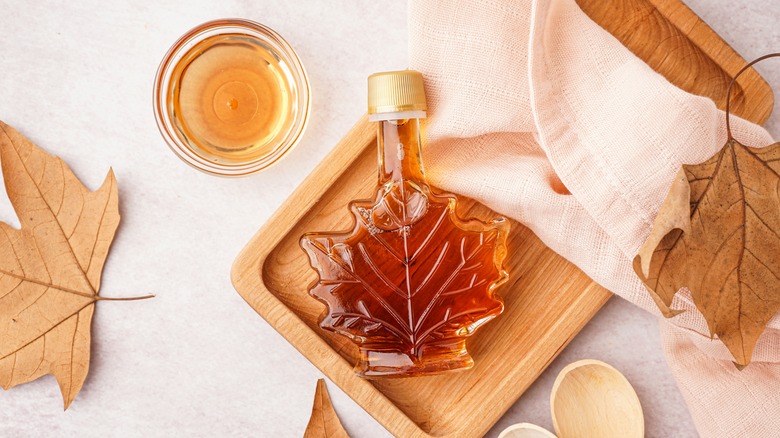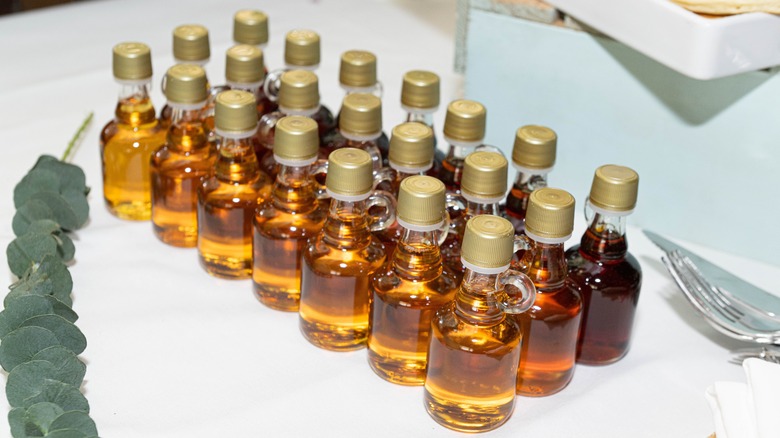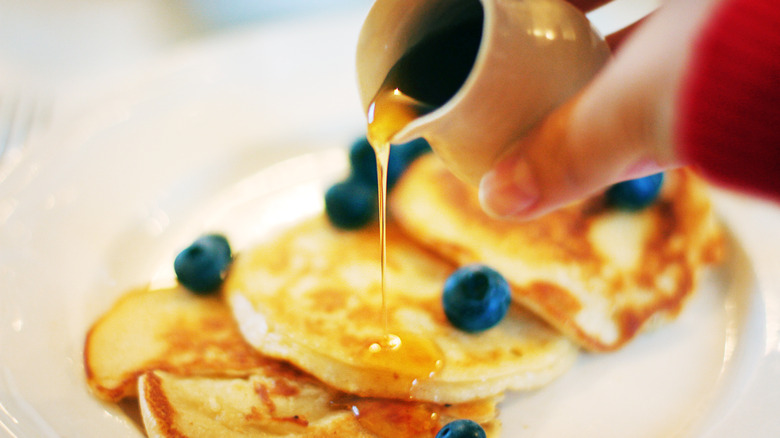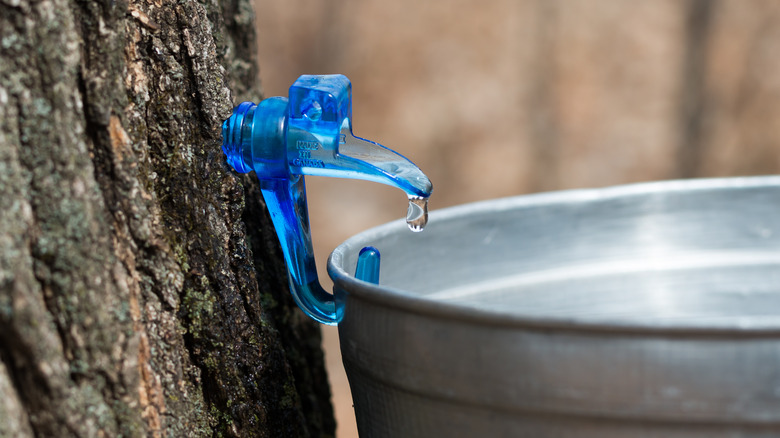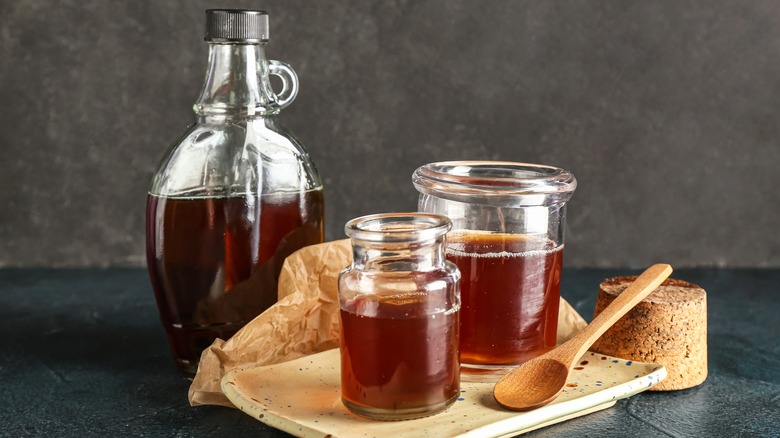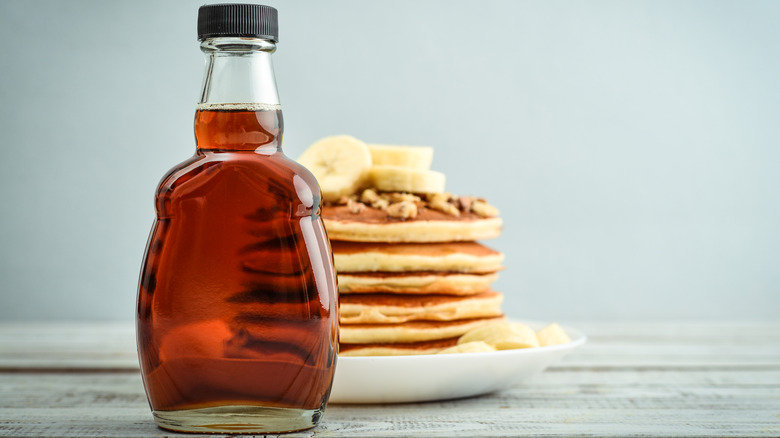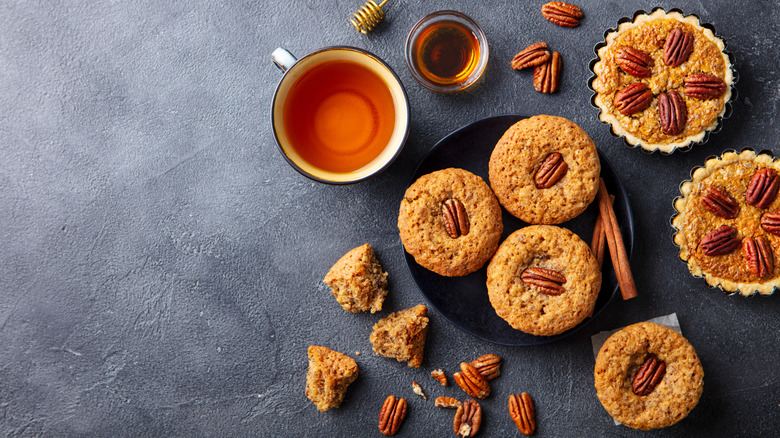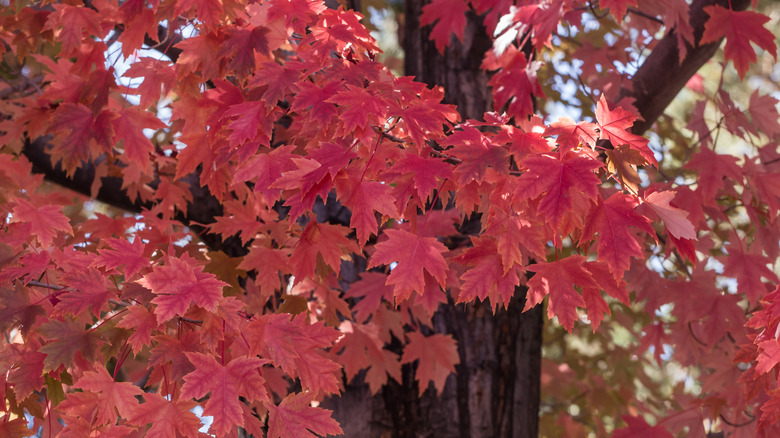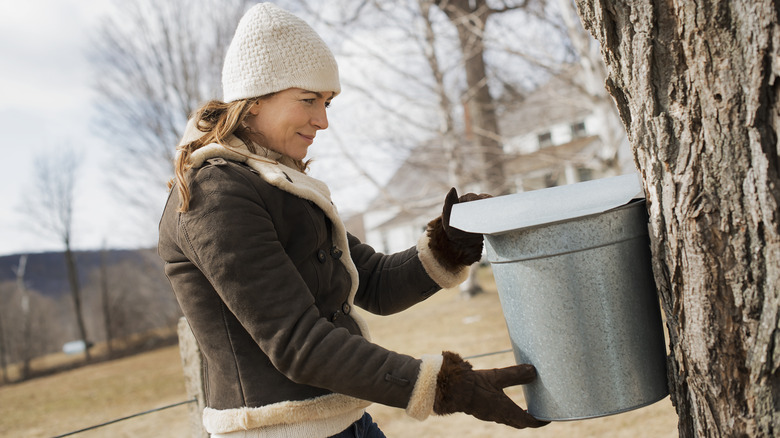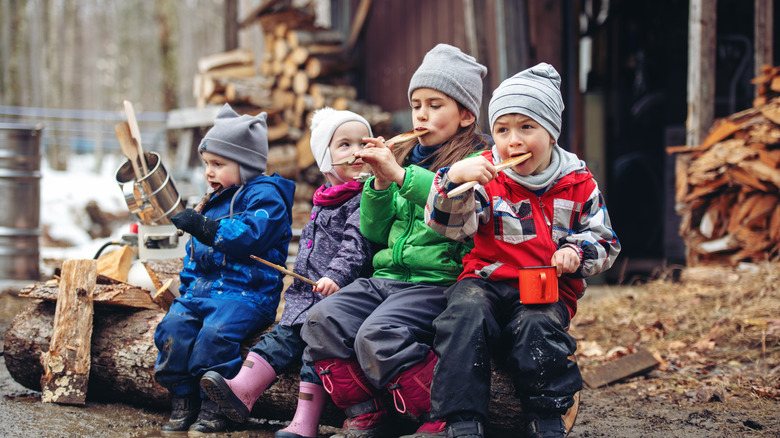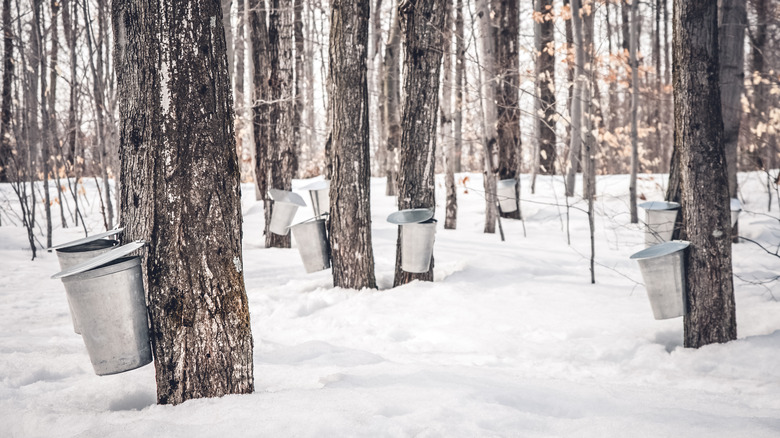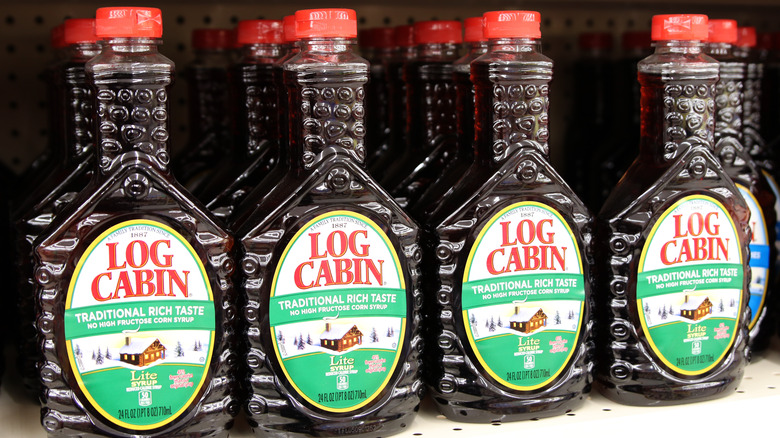False Facts About Maple Syrup You Thought Were True
Maple syrup isn't new to most people. We drizzle it over our pancakes and bake it into granola. There's a bottle in practically every pantry in the U.S. And, it's so valuable and sought-after, that there have been huge maple syrup heists. But, that doesn't mean we know everything about it. Sometimes people think they know facts about this sweet substance that turn out to be untrue. That's why we wanted to explore some of the common myths and misconceptions surrounding maple syrup.
From believing that lighter syrup is always better to assuming that the pancake syrup on your table is maple, it's super common to get the wrong end of the stick. We don't want to burst anyone's bubble here, but we do want people to know the truth behind the fallacies. Whether you're a maple syrup obsessive or you just love learning new information, we're about to hit you with some new knowledge. Here are some false facts about maple syrup you thought were true — and next time anyone brings them up, you'll be ready to bust some myths.
False: The lighter the syrup, the better the taste
People often say that the lighter the syrup, the better it tastes, but this isn't how it works. Different colors of maple syrup have their own flavors, but lighter doesn't necessarily mean better. It's more about your preferences and what you want to use the syrup for.
The lightest maple syrup is known as golden. It has a mild, delicate taste that doesn't come across as super mapley to some. If you're used to a robust maple flavor, you might even be disappointed with golden maple syrup. It's generally used for drizzling over desserts and other sweet treats or adding to salad dressings.
The next lightest is amber maple syrup. This has a medium golden color and a well-rounded flavor. It has more of that classic maple taste that most people are looking for. If you want syrup to pour over pancakes or drizzle onto French toast, this might be what you're looking for.
Next up is dark maple syrup — it has a much more robust maple flavor. Some people find it overwhelming for drizzling directly onto food, but plenty love it, so it's all about preference. That said, it's especially good for cooking and baking with because the maple flavor doesn't cook off when exposed to heat.
Finally, there's very dark maple syrup. It has a strong maple flavor that some find overwhelming for pouring over pancakes or desserts but, again, it's down to preference. It's commonly used by chefs and for commercial purposes, but it's becoming more popular for enjoying at home.
False: Maple syrup grades are an indicator of quality
Many people believe that maple syrup grades are an indicator of quality, but these grades are just used to classify syrups according to the colors discussed above. The reason for this myth is likely down to the old grading system. Prior to the new grading system, which was put into place in 2015, maple syrup was divided into Grade A, Grade B, and Grade C.
Because of the letter grading system, people tended to assume that Grade B was of lower quality than Grade A, and so on. It makes sense to believe this. After all, it's how grades work in school. However, maple syrup grades weren't meant to infer quality. Golden and amber syrups were classed as Grade A, dark syrup as Grade B, and very dark as Grade C or commercial. It was just a way of categorizing them by type.
Eventually, the people in charge realized that the grading system was confusing to customers. As of 2015, the U.S. grading standards consist of Grade A Golden, Grade A Amber, Grade A Dark, and Grade A Very Dark. This helps tell customers that they're all of the same quality. Anything that doesn't meet these standards is sold commercially as Processing Grade.
The color itself has nothing to do with quality, it's all about when the tree is tapped. The lightest syrup comes early in the season when microbial activity in the sap is low. The darkest comes from late in the season when sugar levels have decreased.
False: Maple sap has to be boiled before you can consume it
It's a common assumption that you can't drink maple sap straight from the tree — that it needs to be processed before you can consume it. While it's true that maple sap must be processed to turn it into maple syrup, the sap itself is fine to drink. And, some people even say it has health benefits.
Maple sap is a clear liquid, basically identical to water. It doesn't taste like all that much — just slightly sweet. It's boiling and processing the sap that concentrates the flavor and makes it taste like the maple we all know and love. So, if you get the chance, you can absolutely drink maple sap directly from the tree, just don't expect syrup.
But, how do you get that delicious golden nectar? Once the tree has been tapped and the sap collected, it's put in a piece of gear called a reverse osmosis system. The job of this equipment is to remove as much water from the liquid as possible. After this, it's boiled for a few hours. This causes more water to evaporate and further concentrates the sap until it forms a syrup. To get a single gallon of syrup, it takes around 40 gallons of sap.
False: Maple syrup never expires
Some people might tell you that maple syrup never expires. Well, that's just untrue. But, it's a false fact that many people believe. It might seem like a harmless misconception but it can lead to disappointment. Imagine saving that artisan bottle of maple syrup you got in Quebec, waiting for the perfect time to use it. Then, when you finally do, you get it out of the pantry only to discover that it's gone moldy. Yup, that's right, maple syrup can grow mold — and it's devastating.
So, how long can you expect your syrup to last? A bottle of maple syrup will last for around 12 months. However, you should check the expiry date because you might have less time to consume it if you bought it a while after it was harvested. Maple is tapped and processed during spring, so that might help you determine how much time you've got left.
If it goes moldy, don't despair. You can actually fix moldy maple syrup with a little effort. The mold that grows on it is non-toxic, so you can skin it off or strain it. After this, you should boil your maple syrup for a few minutes to sterilize it. This might seem like a lot of effort, but have you seen the price of maple syrup?
False: You should store maple syrup at room temperature
Think that the best place to store maple syrup is in your pantry? You might have fallen for a common misconception. So many people believe that maple syrup is best stored at room temperature. However, you should actually keep it in the fridge — with a caveat.
The likelihood is you've been storing maple syrup wrong your whole life. The myth probably comes from the fact that you can store most high-sugar foods at room temperature without them growing mold. Honey, molasses, corn syrup, and sugar itself are all fine kept in the pantry and won't grow mold. However, the thing about maple syrup is that it contains more water than these other products and that's what makes it more likely to grow mold.
It's a simple fix, though. Just keep your maple syrup in the fridge and it will last for much longer before it goes moldy. There's one exception, though: unopened maple syrup. While it's still sealed, air can't get in, and it won't grow mold. This is good news if you like to stock up on syrup. You can keep unopened bottles in your pantry, only moving it to the fridge once you've broken the seal.
False: There are limited ways to use maple syrup
We all know that maple syrup is great poured over pancakes, waffles, and French toast. Some of us use it to make granola or granola bars. And, it's also useful in salad dressings and marinades. Many people think that's about it. That there are only a few ways to use maple syrup. The truth is very different — it's an extremely versatile sweetener.
For starters, you can use maple syrup to upgrade your chili. Great chili needs a touch of sweetness to balance out the other elements. Maple syrup is perfect here, because it brings its own complex flavor rather than just adding sweetness. But, there are way more recipes that feature a sweet kick of maple. It's delicious added to roasted vegetables, such as carrots, parsnips, and Brussels sprouts. The sweetness accentuates the already sweet notes that come from roasting. You can add it to mashed sweet potatoes for even more sweetness, or add some chili flakes or chili powder to make an alternative to hot honey.
There are also many sweet recipes that call for maple syrup. It's great in cookies and cakes, sweet potato pie, and caramel corn. You can use it in glazes or frostings. It's also perfect as a sweetener in drinks because it's already liquid and doesn't need to dissolve like granulated sugar does. It works nicely as a vegan alternative to honey in many recipes.
False: Only certain species of maple produce sap that can be turned into syrup
We've regularly heard that only a few species of maple tree can be used to make maple syrup. It's such a common thing to hear that we're not surprised everyone thinks it's true. However, it's not that simple. A few types of trees are commonly used for syrup, but actually any maple tree produces sap that can be turned into syrup.
There are four maple species that people say are the only ones that produce maple syrup: sugar maples, silver maples, red maples, and black maples. Sugar maples are said to be particularly prized for syrup production because their sap contains the highest concentration of syrup. These are the trees usually used for commercial production. However, every maple species produces sweet sap, and it would be possible to turn it into syrup.
The reason these particular species are favored is a combination of flavor and yield. Because they're the maples usually used for syrup, the flavor of their sap is what we think of as a typical maple flavor. Other species may have a slightly different flavor that we wouldn't necessarily recognize as maple as we know it. The yield can also be significantly lower with certain types of maple. The higher the sugar concentration, the less sap is needed to make a gallon of syrup. Sugar maple contains the highest concentration of sugar and that still takes 40 gallons of sap to make a gallon of syrup.
False: You can't tap your own maple tree
Another false fact is that you can't tap your own maple tree. Or, at least, that there's no point in doing so because the yield would be so small. However, this isn't strictly true. Sure, you're not going to get enough syrup to sell at farmers markets or gift to your friends. Still, if you're interested in the process or think it would be fun, you'll end up with enough syrup to make it worthwhile.
An average open-grown maple can produce half a gallon of syrup in a year, and we think that makes it worthwhile. And, if you have more than one in your yard, all the better. Before you get started, though, know it's a fairly involved process and will take a fair amount of time. So, only do it if you're excited about the journey, not just the end result.
If you want to do this, the first step is tapping your tree. You need to drill into it with a household drill, insert a spout, and attach a sap collection container. Empty the container as soon as it gets full, which might be once or twice a day, depending on your tree and weather conditions. Once you have enough sap, it's time to process that maple syrup. While commercial manufacturers have specialist equipment, it's totally possible to DIY it. You can do it on the stovetop, in a slow cooker, or in an Instant Pot.
False: Maple syrup is all sugar and doesn't have any nutritional benefit
A common false fact is that maple syrup is basically just sugar and it has no nutritional value at all. It's seen more like processed sugar syrups and people assume it's just sweet and that's it. So, you might be surprised to learn that maple syrup contains a range of vitamins and minerals.
It's particularly rich in manganese, a mineral important for bone health and metabolism. A third of a cup of syrup contains 165% of the manganese you need in a day. The same quantity of maple syrup contains 28% of your daily intake of zinc, which supports immune function and helps maintain healthy cells. It also contains vitamin B2, potassium, iron, and calcium in smaller amounts. What's more, it has antioxidants in it, which help protect the body from oxidative stress.
This all sounds good on paper and, of course, it's great to get nutrients wherever you can, but this is counteracted by the high quantities of sugar it contains. No amount of vitamins and minerals will make maple syrup actively healthy. It's good to know that it provides you some nutrients, but don't reach for the syrup bottle just to get some extra nutrients. You'd be better off with fruit and veggies or a multivitamin.
False: All maple syrup comes from Canada
So many folks believe all maple syrup comes from Canada, but that's a myth. However, it isn't extremely far from the truth. Roughly 78% of all the world's maple syrup production happens in Canada. Most of that happens in the province of Quebec, which produces 92% of Canadian maple syrup. Smaller quantities are tapped and processed in New Brunswick, Ontario, and Nova Scotia.
So, Canada produces most of the world's maple syrup — where else does it come from? Well, the only other country that makes it is the United States. Within the U.S., it's predominantly produced in New York, New England, Pennsylvania, and Michigan.
It's not that nowhere else in the world has maple trees, but rather that it takes specific weather conditions for sap in maple trees to flow in such a way that you can harvest it to make syrup. The weather needs to reach fairly precise daytime and nighttime temperatures and nowhere else has the proper conditions.
False: Maple syrup and pancake syrup are the same thing
You go to the store and pick up a bottle of pancake syrup. You leave thinking you've bought maple syrup. It makes sense. That's what goes on pancakes, right? Well, if you think maple syrup is the same as pancake syrup, you've fallen for a popular myth. It's not your fault, though, it's one that the makers of pancake syrup want you to believe.
Look at bottles of pancake syrup and you'll often see imagery of quaint cabins and fall leaves. This might trick you into thinking it's maple. It may also be called maple-flavored syrup or something similar. Although, fun fact: in Vermont, it's illegal to call syrup maple or maple-flavored unless it consists of nothing but maple syrup. That's why you won't find artificial maple syrup in Vermont IHOP locations. Only the real stuff will do for Vermonters.
So, what's the difference between maple syrup and pancake syrup? Well, it's a simple one. Maple syrup is made using the sap from maple trees — nothing else. Pancake syrup can be any type of syrup, but it's usually something cheap and highly processed, such as high fructose corn syrup. It will also have other additives, such as caramel coloring to make it look more like maple syrup. Plus, it might have maple flavoring, but it's not true maple syrup.
